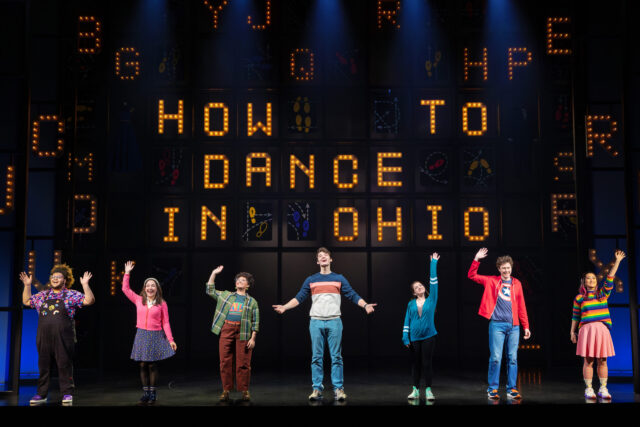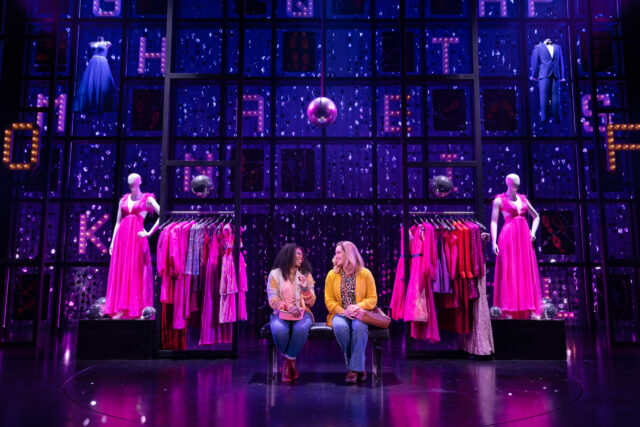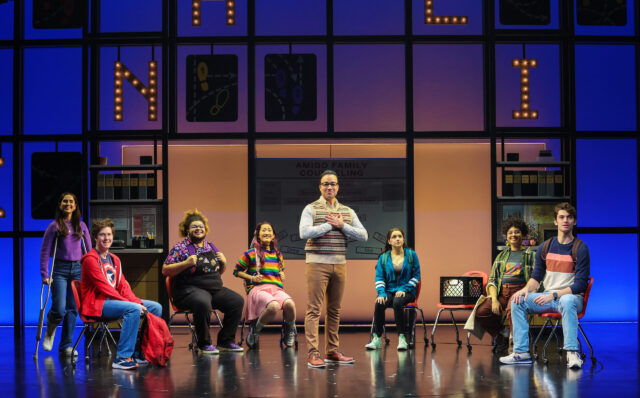
Seven autistic actors portray seven autistic characters in Broadway premiere (photo © Curtis Brown)
HOW TO DANCE IN OHIO
Belasco Theatre
111 West 44th St. between Sixth & Seventh Aves.
Tuesday – Sunday through February 11, $74 – $518
howtodanceinohiomusical.com
“Will I be totally humiliated if I mess it up?” Remy (Desmond Luis Edwards) asks in the Broadway premiere of Rebekah Greer Melocik and Jacob Yandura’s How to Dance in Ohio, which opened last night at the Belasco. It’s a question that we’ve all asked ourselves, and it’s a central theme of the musical, which focuses on seven autistic young adults trying to make connections while preparing for a spring formal, dealing with the same types of emotions as neurotypical people but facing a world that was not built with them in mind.
The two-and-a-half-hour show (with intermission), which was developed and first presented at Syracuse Stage, was inspired by Alexandra Shiva’s Peabody Award–winning documentary about Amigo Family Counseling in Columbus, Ohio, which provides “Respons· ability Social Therapy” for individuals with Autism Spectrum Disorder. The film featured more than two dozen child and adult clients — they avoid such words as “patients,” “sufferers,” and “victims” — but the musical has trimmed it down to seven young adults, each with one particular disorder. Although some of the characters are based on specific clients, they are all amalgams; none is an exact representation, with various changes made for dramatic purposes.
The clinic was founded by Dr. Emilio Amigo (Caesar Samayoa), who, in the show, runs it with the help of his daughter, Ashley (Cristina Sastre), a ballerina at Juilliard who is recovering from a fractured leg and reconsidering her future as a dancer. (The actual clinic has a handful of therapists, specialists, and aides covering several different groups.) AFC has seven clients: Remy (Desmond Luis Edwards), who wants to be a stylish viral superstar; Caroline (Amelia Fei), who is starting college and has her first boyfriend; Jessica (Ashley Wool), a dragon lover who wants to move out of her mother’s house; Drew (Liam Pearce), an electrical engineering wiz choosing which university to attend; Mel (Imani Russell), who is seeking a promotion at the pet store where she works; Tommy (Conor Tague), who hates collared shirts and is getting ready to take his driving test, excited to get behind the wheel of his brother’s new truck; and the newest member of the group, Maredith (Madison Kopec), who is obsessed with facts.
“I am going places / There are places I need to be,” the group sings. “But, most of the spaces / that I want to get to / were not designed for me.” They explain, “That’s what we do in Ohio: / Doing the same thing over and over.” Jessica says self-referentially, “Like lines of a play, or a song’s refrain.”

Terry (Haven Burton) and Johanna (Darlesia Cearcy) go dress shopping with their daughters in How to Dance in Ohio (photo © Curtis Brown)
At Maredith’s first session, Dr. Amigo tells everyone to “circle up!,” passing around a long white rope as each client shares something personal, slowly connecting them all, even if they’re not necessarily comfortable with it. The fears and anxieties they face range from tying shoelaces and answering telephones to speaking with strangers and being touched. Some have trouble showing emotions and setting boundaries, and most have repetitive habits. “Repetition creates reality,” Mel notes.
Dr. Amigo decides to hold a spring formal at the Encore nightclub, a dance where the group can face their social awkwardness while practicing communication skills and experiencing a rite of passage. It sounds like a terrible idea — especially when he encourages them to bring dates, whether from within the group or outside it — but Dr. Amigo wants his clients to take that next step.
“Disaster is always a possibility / Real life is loud, confusing, fast / We shelter our children because we care / But how long can childhood last?” he tells Columbus Gazette reporter Shauna Parks (Melina Kalomas), adding, “Because victory is also a possibility / Your odds improve each time you try / Your skin gets thicker, failure stings a bit less / and maybe that’s worth all the worry and stress.” The doctor is also meeting with blogger Rick Jenkins (Carlos L Encinias), who wants to do a big piece on the dance.
As the event nears, Drew’s parents, Amy (Melina Kalomas) and Kurt (Encinias), are concerned about Dr. Amigo’s influence over their son; Jessica’s mother, Terry (Haven Burton), and Caroline’s mom, Johanna (Darlesia Cearcy), take their daughters dress shopping at Macy’s while Maredith’s widowed father, Michael (Nick Gaswirth), can only afford discounted clothing at Dress Barn; and the clients consider how they will pair up for the formal.
How to Dance in Ohio is dedicated to Hal Prince, who was originally going to direct the production before he died in 2019 at the age of ninety-one. His granddaughter Lucy Chaplin is autistic and served as inspiration to Shiva. Melocik, who wrote the book and lyrics, has Tourette’s syndrome, and Yandura, who composed the music, has an autistic sister.
Directed by Sammi Cannold in her Broadway debut, the show moves like clockwork, at a swift, even pace, with evocative, if unspectacular, songs (“Today Is,” “Under Control,” “Drift,” “Terminally Human,” “Building Momentum,” “Two Steps Backward”) and choreography by Mayte Natalio, lighting by Bradley King, and sound by Connor Wang that all take into consideration how movement, noise, and flashing lights can affect not only the seven autistic actors but audience members as well. There are cool-down spaces in the mezzanine and lower lounge for anyone who might need to take a break, in addition to sensory bags with fidget toys and glasses that are available for borrowing at the merch stand. Robert Brill’s set consists of LED letters arranged in grids in the back and on columns on either side, along with rectangles of numbered dance steps; location changes either descend calmly from above or from the wings as the narrative shifts from a room in the clinic to stores, a nightclub, a bus stop, and several characters’ homes.

Dr. Emilio Amigo (Caesar Samayoa) prepares his clients for a spring formal in How to Dance in Ohio (photo © Curtis Brown)
Unfortunately, the book is laden with problems, primarily when Melocik strays from the documentary and invents subplots involving the reporters, class difference, and Dr. Amigo’s battles with parents over his possible interference in their children’s lives. The additions seek to give voice to the seven young adults and educate theatergoers about the right words and approach when talking about or to people with autism, but it displays a lack of confidence in the audience to figure that out by the action that unfolds in front of them; instead, we’re hit over the head with teaching moments that don’t ring true.
None of that detracts from the production itself; the seven autistic actors, all Broadway newcomers, are terrific, and they seem to be having the time of their lives onstage. When Edwards, as Remy, looks into his ring light and says, “This is the ‘Many Faces of Me,’ with me, Remy: live! I see you, Tommy! — Our first topic is: Nothing about us without us,” he is speaking for the neurodivergent community as a whole, celebrating their multifaceted existence. When Drew offers to lend a book about Pangea to Marideth, it’s a subtle metaphor for the seven clients: Pangea was the single land formation that eventually broke into the seven continents, evoking how the clients are unique individuals who should not merely be seen as a group unto themselves.
Samayoa (Come from Away, Sister Act) is the glue that holds it all together, with solid support from Sastre, Burton, Cearcy, Encinias, Gaswirth, and Kalomas, although some minor characters are underwritten, there just to push through a small, forced story point.
In a 1980s public service announcement for United Cerebral Palsy that has stuck with me for decades, actor Tony Danza asks, “How do you treat a person with a disability?” After receiving a variety of comments from several random people in the street, Danza shares the answer: “Like a person.” That essentially is what How to Dance in Ohio is attempting to convey in regard to autism, and it does so with an abundance of charm, even though it occasionally goes astray. But it gets to the heart of so much of what makes us all human, as we progress from children to teenagers to young adults: learning to drive a car, going out on a first date, selecting a college, choosing a social media presence, and building momentum to be able to eventually live on one’s own.
[Mark Rifkin is a Brooklyn-born, Manhattan-based writer and editor; you can follow him on Substack here.]